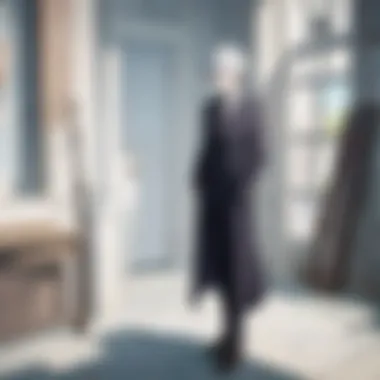In-Depth Analysis of The Promised Neverland Season 2 Episode 1


Preface to the Series
'The Promised Neverland' is a captivating series that juggles elements of horror, mystery, and psychological thriller. Originally a manga created by Kaiu Shirai with illustrations by Posuka Demizu, it dazzled audiences upon its serialization in 2016. The anime adaptation premiered in January 2019, quickly gaining a notable following due to its gripping narrative and well-defined characters.
The story is set in a seemingly idyllic orphanage where children discover the dark truth behind their existence. Themes of survival, friendship, and betrayal are rife throughout the series, offering a profound exploration of human nature under dire circumstances. Its capacity to delve into the psyche of its characters while maintaining suspense has played a pivotal role in its popularity.
Background Information and Context
As the series progresses, additional layers of complexity emerge, exposing the various moral dilemmas faced by the main characters. The first season crafts an intricate tapestry that sets the stage for deeper explorations, which carry into Season 2. This continuation refines the thematic richness expanded throughout its informed narrative.
Insight into the Popularity and Reception
The initial reception of The Promised Neverland was overwhelmingly positive, with critics and fans lauding its unique storytelling and intricate character development. The complex moral questions it poses keep discussions alive long after episodes air. Its following is akin to that of other prominent series in the genre, such as Attack on Titan and Death Note, drawing fans into debates on anime forums like reddit.com. Its high ratings have solidified its status as an essential part of the modern anime landscape, making its return in Season 2 highly anticipated.
"A psychological thriller that not only entertains but also provokes thoughts about the very essence of humanity."
Prelims to The Promised Neverland
Understanding the significance of The Promised Neverland is essential for its fans and new viewers alike. This series combines elements of horror, psychological tension, and complex character dynamics. It explores themes that resonate deeply with its audience, such as morality, hope, and survival in the face of despair. The profound narrative provides a unique lens into human behavior under extreme conditions. Moreover, the ethical dilemmas presented challenge viewers to reflect on their own beliefs and values.
Overview of the Series
The Promised Neverland follows a group of orphans who discover the dark truth behind their idyllic life at Grace Field House. They realize they are being raised as livestock for a demonic society. This revelation transforms their innocence into a desperate struggle for freedom. The story introduces us to Emma, Ray, and Norman, who must devise a plan to escape and protect their younger siblings. Each character represents different coping mechanisms and philosophies about survival. The pace and suspenseful storytelling keep audiences engaged, making it a standout in the anime landscape.
A Brief Recap of Season One
Season One establishes the foundation of the series, introducing characters and the shocking world they inhabit. The arc emphasizes their friendship, resilience, and strategic planning. Key events include the children's discovery of their fate, their first attempts to escape, and the intense emotional moments that solidify their bonds. The climax centers around a confrontation with a formidable foe, ensuring that viewers are left with a mix of excitement and uncertainty as they await further developments. This recap is pivotal as it sets the stage for the second season, priming viewers for the continuation of these characters' journeys and the unfolding of new challenges.
Key Themes in The Promised Neverland
The Promised Neverland is rich in themes that resonate with its audience. These themes serve as the backbone of the narrative and add layers to character motivations. Understanding these key themes is essential to fully appreciate the depth of the series. In this section, we will explore the themes of survival and sacrifice, as well as friendship and betrayal. Each plays a critical role in highlighting the emotional weight and moral dilemmas faced by the characters.
Survival and Sacrifice
Survival is not just a central theme; it is an existential reality for the characters of The Promised Neverland. The scenario in which the protagonists find themselves forces them to make difficult choices. They must constantly navigate a world filled with dangers. This often means putting their own desires on hold for the greater good. The need to survive serves as the catalyst for many plot developments.
Characters like Emma embody this theme through her relentless quest to save her friends. Her determination often leads her into situations where sacrifices are necessary. The series poses the question: how far would one go to protect loved ones? This dilemma is not simply theoretical; it manifests in challenging, heart-wrenching decisions. The portrayal of survival is intricate. It shows that it often comes at a high cost, involving emotional, moral, and physical sacrifices.
In Season 2 Episode 1, these elements are laid out clearly. The stakes have never been higher, and the choices made by the characters echo the sacrifices of season one. The audience can easily see how survival instills fear but also resilience and ingenuity. Each character's will to survive creates powerful narratives throughout the season.
Friendship and Betrayal
Friendship forms the emotional core of the series. It highlights the bonds between characters, making their struggles more poignant. The friendships in The Promised Neverland are tested repeatedly. A significant theme is how trust can be both a source of strength and potential vulnerability.
When faced with dilemmas, characters often find themselves at a crossroads between loyalty and self-preservation. This theme underscores the emotional tension rooted in teamwork. The friendships that develop are sometimes complicated by betrayal, creating dramatic stakes. Examples from early episodes illustrate how betrayal among friends can shatter trust. This theme circulates heavily in Episode 1 of Season 2, drawing on past disputes and building tension for what lies ahead.
"The delicate balance of friendship and betrayal enhances the emotional resonance of the story."
The dichotomy of friendship and betrayal serves to enrich the narrative. By illustrating the fragility of trust amid chaos, The Promised Neverland encourages the audience to think critically about relationships. Trust is portrayed not just as a bond but as a potential double-edged sword.
By examining these themes, viewers gain insight into the characters' motivations and the overall narrative. This makes engaging with the series a rewarding experience, as it challenges the audience to reflect on their own perceptions of friendship, loyalty, and sacrifice.
Setting the Context for Season Episode
Understanding the context leading into Season 2 Episode 1 of The Promised Neverland is essential for grasping the depth of the narrative and the character developments that unfold. The events that transpired in Season One play a crucial role in setting up the stakes and expectations for the audience. This section seeks to illuminate the critical points from the previous season while also addressing audience anticipations for what is to come. By laying this groundwork, we enrich our analysis of the episode itself, creating a more comprehensive narrative that explores the implications of each development.
Where We Left Off
At the end of Season One, viewers are left in a state of tension and uncertainty. The escape plan of Emma, Ray, and the other children seemed successful but not without devastating consequences. They managed to evade their pursuers and secured their freedom, yet the harsh realities of the world outside the farm await them. The audience witnessed the emotional toll of their experiences, as friendships were tested and betrayals occurred. Knowing that the free world is fraught with dangers adds a layer of complexity to the characters' journeys.


The final episodes hint at major decisions that Emma and the others must face. The question remains: how can they build a new life when shadows from their past loom large? Each character carries the weight of their experiences, intensifying interest in their emotional and mental states as Season 2 unfolds.
Anticipations for the New Season
With the anticipation for Season 2 high, fans have their theories and expectations. The shift from the safety of the farm into the unknown poses important questions regarding survival tactics, alliances, and moral choices. Here are some anticipations of the audience:
- Development of Relationships: How will Emma's relationship with Ray evolve now that they are free? Will unresolved tensions come to a head?
- New Characters: The introduction of new characters is likely. Who will join the main cast, and what will their motivations be?
- Moral Dilemmas: The moral complexities surrounding the lives they lead will not diminish. Expect challenges that force the characters to confront their ethics.
- World Building: The audience is eager to learn more about the wider world beyond the farm. How extensive are the dangers, and what resources exist?
Overall, as Season 2 begins, viewers are keenly aware that the stakes have increased significantly. The world is more expansive, and with it comes new opportunities and threats. In this context, Episode 1 serves as a crucial link between the last season and the unfolding narrative. Understanding where the story stands now sets a solid foundation for engaging with the episode's plot and themes.
Episode Overview
The overview of "The Promised Neverland" Season 2 Episode 1 serves as a critical foundation for understanding the trajectory of the series. This episode reestablishes the core themes and characters while also introducing new elements that expand the narrative. By focusing on the key plot points and character dynamics, viewers gain insight into what lies ahead in the season.
In this section, we will delve into the plot summary, which outlines the main developments in the episode, and the character introductions and reintroductions that shape the unfolding story.
Plot Summary
Season 2 Episode 1 opens with a stark contrast to the previous season’s intensity. The episode begins by depicting a world that has changed since the events of the first season. We find our main characters, Emma, Ray, and their friends, facing the consequences of their escape from the Grace Field House. The bleakness of their new reality is immediately palpable as they navigate the dangers of their environment and the looming threats from the demons.
The pacing of the narrative in this episode is deliberate, allowing viewers to absorb the gravity of their situation. Key moments highlight the struggles of the characters as they search for safety while clinging to hope. They are no longer just children fleeing their former lives; they have become proactive in their quest for freedom.
One pivotal moment in this episode is when Emma reveals her unwavering desire to save all the children, not just those who escaped with her. This desire underscores the central theme of survival, as Emma has to balance her ideals with the harsh realities they face. The tension builds steadily as they encounter new enemies and obstacles in their path.
Overall, the plot summary illustrates how this episode sets the tone for the season. It not only revisits past tensions but also introduces a new layer of complexity to the narrative, which is crucial for future developments.
Character Forewords and Reintroductions
In this episode, we see both new faces and familiar ones returning, each contributing to the rich tapestry of the story. The introduction of new characters is timely, as they add depth and fresh complexity to the challenges the protagonists must overcome.
Emma remains the heart of the narrative. Her brave and impulsive nature continues to challenge her friends and herself. Ray reemerges as a voice of reason, often balancing Emma’s more idealistic approach with his pragmatic perspective. The dynamics between these characters are pivotal, as they reflect the themes of friendship and betrayal that permeate the series.
Additionally, newcomers in this episode are significant. They provide different viewpoints and motivations, expanding the narrative beyond the main trio. As the episode unfolds, each character’s backstory hints at larger conflicts and allegiances, suggesting intricate relationships and dramatic tensions are in store for the season.
The balance of reintroducing established characters while welcoming new faces is well-executed. This allows viewers to reconnect with their favorites while also keeping the story fresh and engaging.
Analysis of Key Characters
Emma's Development
Emma emerges as a central figure in the first episode of Season 2. Her character arc from Season 1 to this episode is marked by significant transformation. Initially, she is portrayed as the naive, hopeful child. However, the events she experiences shape her into a decisive and resilient leader. In this episode, her determination to protect her friends remains evident. She is no longer just a survivor; she has evolved into a strategist. The weight of past decisions haunts her, which adds depth to her narrative. Her development suggests that the emotional scars she carries will continue to impact her choices in future episodes.
Key moments highlight her ability to balance hope with the harsh realities of their existence. The dialogue and interactions with other characters paint a picture of someone who is grappling with the need to be strong for others. She is noticeably more aware of the stakes. This shift signifies a crucial step in her journey, setting the tone for the challenges she must face ahead.
Ray's Return and Its Implications
Ray's reintroduction in the first episode is a pivotal moment for the narrative. His character serves as a contrast to Emma's. While she is driven by hope, Ray embodies pragmatism and a certain sense of foreboding. His absence in previous events creates a layer of anticipation among fans. The dynamic between him and Emma in this episode is fraught with tension. He brings a more realistic perspective. This can create conflict within the group, suggesting that differing opinions will play a crucial role in their strategy against the looming threats.
The implications of Ray's return extend beyond character relationships. He introduces new theories and strategies that challenge the status quo. His knowledge from the past becomes a valuable asset and raises the stakes for future decisions. The viewers are left pondering how his character will influence both the group dynamics and the overarching plot. By acknowledging his experiences, the audience gains insight into unresolved issues from Season 1. Ray becomes not just a participant but an essential player in the unfolding story.
Visual and Technical Aspects
Visual and technical aspects play a vital role in any anime series. In the context of The Promised Neverland Season 2 Episode 1, these elements enhance the viewing experience, offering depth that goes beyond the narrative alone. The audience engages not only with the story but also with how it is presented. Attention to animation quality and sound design significantly influences how themes and emotions are conveyed.
The visual elements set the mood, highlight characters’ emotions, and emphasize critical moments in the story. Technical aspects like sound create an atmosphere that can either heighten tension or provide moments of relief. Thus, the analysis of these components is crucial for understanding the episode's overall impact.
Animation Quality
The animation quality in The Promised Neverland Season 2 is commendable. The studio's commitment to fluid movement and expressive character design is evident. The attention to detail in the environments creates a visually rich experience. For instance, backgrounds are not mere backdrops; they reflect the mood of scenes and the emotions of characters.


The first episode shows a notable advancement in animation techniques. Action scenes are crisp, showcasing a fluidity that captures the intensity of events. In softer moments, the animation shifts to highlight character expressions, adding a layer of nuance to interactions. The choice of color palettes also plays a significant role. Darker tones dominate scenes with tension, while lighter hues accompany more hopeful moments.
To summarize, animation quality in this episode not only serves aesthetic purposes but also reinforces the series' themes, creating a more immersive experience for viewers.
Soundtrack and Sound Design
The soundtrack and sound design are equally important in shaping the atmosphere of The Promised Neverland. The series utilizes a mixture of orchestral pieces and electronic sounds that effectively complement the narrative. The opening themes are emotionally charged, setting the tone right from the start. They create an expectation for both suspense and drama as the plot unfolds.
In episode one, sound design plays a pivotal role in building tension. Subtle ambient sounds enhance scenes, making environments feel alive. Whether it is the rustling of leaves or distant echoes, these details add a layer of realism.
The use of silence is also noteworthy. Pauses in dialogue or action can amplify dramatic moments, capturing the viewer's attention. The sound team shows a mastery of timing that keeps the audience engaged.
Overall, the combination of an evocative score and effective sound design elevate the storytelling, making it more impactful for the viewer.
Narrative Techniques
In analyzing Season 2 Episode 1 of The Promised Neverland, the narrative techniques employed stand as a crucial element in developing the story. These techniques encompass various strategies that enhance storytelling, build tension, and convey themes effectively. By examining these components, one gains insight into how the episode sets the tone for the season, and how it engages the audience.
Pacing and Tension Building
The pacing in The Promised Neverland is a key factor that significantly influences the viewer's experience. This particular episode utilizes a steady pace that alternates between gripping moments of action and quiet, contemplative scenes. The opening sequence creates an immediate sense of urgency, presenting the characters in a dire situation. This swift engagement hooks the audience right from the start.
Consider the transition between action and dialogue; it serves to build tension. For instance, moments of silence are strategically placed after intense scenes, allowing viewers to absorb the gravity of the situation. The characters' emotions are palpable, making their concerns feel immediate and real. This cyclical rhythm of tension and release is vital for maintaining viewer interest and emotional investment.
"The art of pacing lies not just in speed, but in how the narrative allows moments to breathe."
Moreover, the strategic use of cliffhangers at the episode's conclusion serves to propel the audience into anticipation for the next installments. Each segment of the plot is meticulously crafted to maintain stakes and interest. Consequently, the pacing in this episode exhibits how effective narrative techniques can convert mere events into compelling storytelling.
Foreshadowing Elements
Foreshadowing is another significant narrative technique used in the episode. This is observed through subtle hints dropped throughout the dialogue and visuals, suggesting future developments. These elements are crucial for building suspense and eliciting curiosity from the audience.
For example, certain character interactions imply deeper connections and potential conflicts that may arise later in the season. The creators cleverly embed these foreshadowing cues, enriching the fabric of the narrative. Fans familiar with the manga or prior season can deduce possible trajectories, creating a layered viewing experience.
Additionally, visual indicators such as background imagery or character expressions sometimes suggest underlying themes. The atmosphere can often reflect tension or impending doom, enhancing the storytelling without overt exposition. This layered approach not only rewards attentive viewers but also deepens the overall narrative complexity of the show.
In summary, the narrative techniques of pacing and foreshadowing play a critical role in establishing the tone and emotional depth in Season 2 Episode 1 of The Promised Neverland. By keeping audiences engaged through well-timed tension and subtle hints, the episode lays a strong foundation for the unfolding storyline. This careful crafting not only sustains interest but also builds a substantial framework for future developments.
Audience Reception and Critics’ Perspectives
Audience reception and critics' perspectives are essential components in understanding the impact of The Promised Neverland Season 2 Episode 1. These elements not only shape the ongoing narrative of the series but also provide insight into its cultural resonance. In this analysis, we delve into two primary aspects: viewership statistics and critical reviews following the episode's release.
Viewership Statistics
The success of any television series, particularly in the anime realm, often hinges on its ability to attract and retain viewers. For The Promised Neverland, the initial episode of Season 2 garnered significant attention, indicated by the viewership statistics available soon after its release. With over 1 million streams in the first week alone, the episode demonstrated a robust level of interest among both existing fans and new viewers.
This high viewership can be attributed to several factors:
- High Anticipation: Following the cliffhanger ending of Season 1, many fans were eager to see how the story would unfold.
- Effective Marketing: The promotional strategies employed, including social media campaigns, helped maintain excitement for the series.
- Accessibility: Streamlining options through platforms like Crunchyroll and Funimation made it easier for fans to access the episode right away.
In a competitive landscape, these statistics highlight the show’s continued relevance and popularity, establishing a benchmark for future episodes.
Critical Reviews Post-Episode
Critical reception to the premiere of Season 2 has been mixed, mirroring the complexity of the series' narrative itself. Various critics took to different platforms, such as anime blogs and social media, to express their views. While some reviews praised the emotional depth and character development evident in the episode, others pointed to concerns regarding pacing and fidelity to the original manga.
Important points raised in critical reviews include:
- Character Development: Many praised how the episode deepened existing character arcs, particularly for figures like Emma and Ray.
- Pacing Issues: Some critics noted that the episode's pacing felt rushed, possibly leaving casual viewers confused about critical plot points.
- Visual Quality: The animation quality received mixed reactions, with specific sequences lauded for their detail, while others prompted questions about consistency compared to Season 1.


As noted in one review,
"While The Promised Neverland Season 2 tries to recapture its initial magic, the deviation from source material has left some fans feeling alienated."
Overall, the reception of the episode reflects both the evolving nature of the series and its dual potential to excite and alienate its audience. Critics and viewers alike contribute to a richer understanding of how the narrative might evolve in subsequent episodes. This reception landscape is critical in informing the creators about audience expectations and potential adjustments needed moving forward.
Comparative Analysis with Manga
The exploration of the differences between the anime adaptation and the manga source material is crucial for understanding how The Promised Neverland evolves its storytelling. This section will unpack the specific elements and implications of these variations. Anime adaptations often make specific choices on pacing, character development, and visual representation to fit the format and target audience.
Not only does this allow a broader exploration of themes, but it also sheds light on the narrative constraints of the medium. While both mediums share the same core story, certain elements diverge, leading to unique interpretations. Appreciating these nuances enhances the viewer's experience, as one begins to see the strengths and weaknesses of each form of storytelling.
Differences in Storytelling
The storytelling in the anime frequently diverges from the manga in terms of pacing and depth. The manga, created by Kaiu Shirai and illustrated by Posuka Demizu, offers a more intricate exploration of the emotional and psychological complexities of the characters. Certain chapters provide deeper insights into backstories, enriching the viewer's understanding of motivations.
In contrast, the anime may condense or skip specific scenes for brevity, leading to a shift in character dynamics and motivation. For example:
- Pacing: The anime's tempo is quicker, often leading to a more suspenseful but less detailed narrative.
- Character Focus: Some characters receive less focus in the anime, while the manga often develops secondary characters more thoroughly.
These differences can alter the weight of specific events, as they may lack the context or emotional resonance found in the manga.
Character Representation
Character representation is a significant aspect of how the story is perceived in both mediums. The manga has highly stylized illustrations that convey a range of expressions and subtleties, shaping how characters are understood. The detailed drawings provide nuance that can sometimes be lost in animation.
In the anime, characters may have more limited expressions due to animatadion constraints. Furthermore, some characters may be portrayed by voice actors whose interpretations influence perception. Consider how Ray is depicted:
- Manga: Depicted with a brooding complexity that showcases his internal conflicts.
- Anime: Portrayal leans towards a more straightforward interpretation, affecting viewers’ connections to his turmoil.
This can create a disconnect for audiences familiar with the manga, highlighting the importance of understanding both forms for a fuller appreciation of character motivations and relationships.
No medium is inherently superior; each has its unique strengths that contribute to the storytelling.
Future Implications for the Series
As we assess the events of Episode 1 of Season 2 of The Promised Neverland, it becomes evident that the foundations laid in this episode have far-reaching implications. Understanding these future consequences is necessary for both fans and critics when engaging with the unfolding narrative. There are several key elements that should be considered.
Speculations for Subsequent Episodes
The introduction of new settings and characters presents numerous possibilities for plot development. Viewers can anticipate deeper explorations of character motivations, especially as they face new antagonists. The first episode hints at darker themes poised to emerge, particularly surrounding the revelations of human farming and its implications for society.
Specifically, the interactions between Emma, Ray, and the new characters will likely shape their paths in ways that can redefine alliances and enmities. The ominous tone in the episode sets a stage where every decision can lead to unforeseen consequences.
"The Promised Neverland is not just about survival; it is about the moral dilemmas faced while navigating a perilous world."
Furthermore, important character choices will spiral into broader conflicts. For instance, how will Emma's idealism hold up against harsh realities? Fans may speculate on character fates, potentially influencing emotional engagement in upcoming plots. This uncertainty cultivates suspense, making viewers eager to watch how these developments unfold.
Long-term Character Arcs
Character arcs represent one of the strengths in The Promised Neverland. Season 2 is expected to deepen existing arcs while introducing new ones. Emma is likely to face challenges that test her beliefs about humanity and redemption. As the group encounters threats, her leadership skills will be put to the test.
Ray's character is another focal point. His struggles with trust and sacrifice set a complex stage for future episodes. Viewers may see an evolution of Ray's persona from a strategist to someone who may need to confront his past decisions and their impact on the group.
As each character grapples with intense emotional and physical challenges, the stakes will inevitably rise. The narrative is positioned to explore themes of loyalty and the burdens of leadership among young individuals thrust into a drastic reality. This exploration will not only highlight personal growth but also weave a larger narrative that reflects the series' overarching themes.
Finale
The conclusion serves as a critical summation of the in-depth analysis presented throughout the article. It allows the reader to reflect upon the significant themes and narrative developments introduced in Season 2 Episode 1 of The Promised Neverland. It underscores the momentum that has been built from Season One, setting a tone for what is to come. Through the lens of this episode, many core elements of the series are explored, such as character growth, plot progression, and thematic depth.
Final Thoughts on Episode One
The Promised Neverland Season 2 Episode 1 effectively re-engages viewers by re-establishing critical plot points while hinting at new challenges. The episode does not shy away from the previous emotional weight carried by the characters. It balances the urgency of past traumas with the hope for a brighter future. Characters like Emma demonstrate resilience, and her determination fuels the narrative drive. Viewers are invited to reflect on how past experiences shape current decisions. This episode reignites the emotional connection that fans have developed, urging them to invest in the unfolding story once more.
Looking Ahead in the Series
As we consider the implications of Episode 1, the future of The Promised Neverland is rich with possibilities. Speculations abound regarding character arcs and potential plot twists. Audiences may expect deeper explorations of themes such as desperation and loyalty. The established framework of sacrifice may lead to crucial decisions that will define the characters’ journeys. Significant character interactions will likely evolve as alliances shift and new threats arise. Examining this episode sets the stage for profound narrative evolution in the coming episodes, provoking curiosity about how these elements will unfold.















